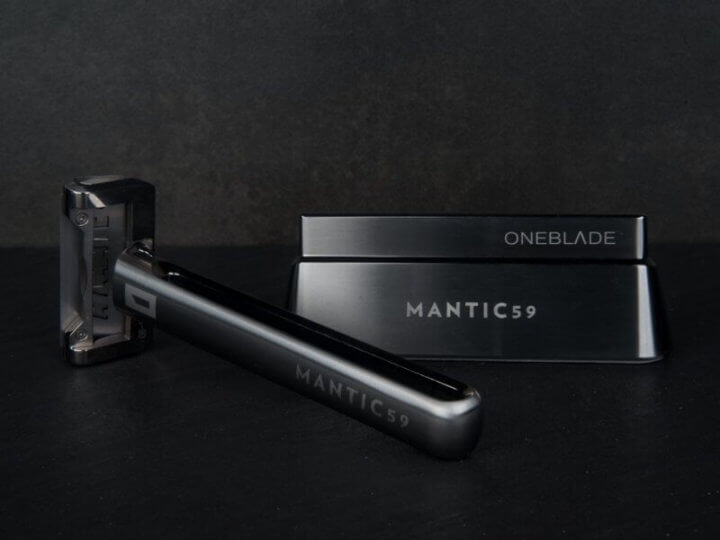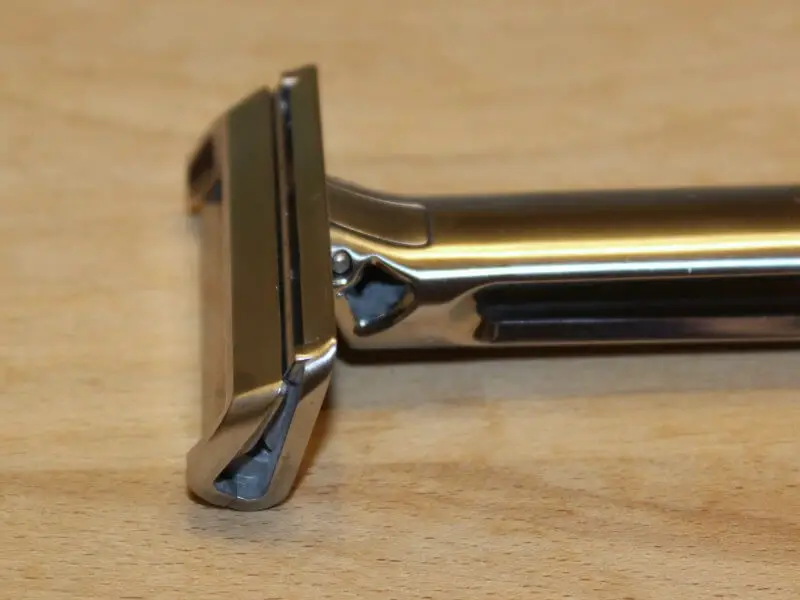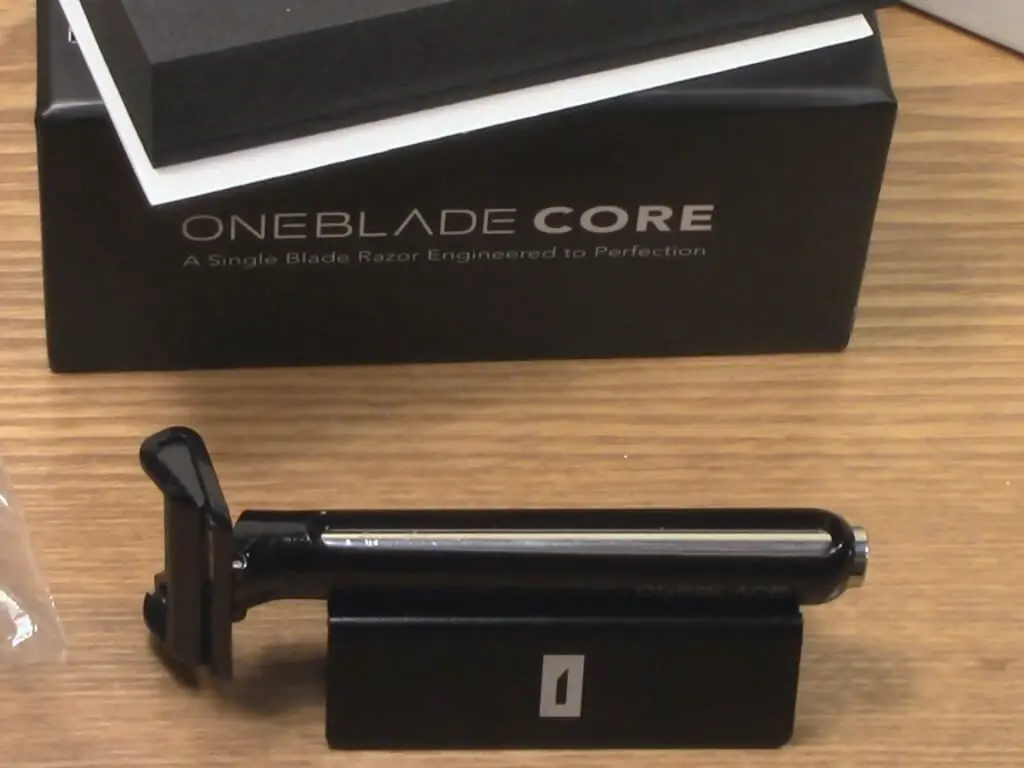
[Updated September, 2020] I first talked about the OneBlade razor (now called Genesis) in 2015. In that time it has become my favorite, most-used razor. Let me give you my long-term evaluation of the OneBlade razor with this “one blade review.”
The OneBlade Difference?
[Note: Oneblade is a long-time Sharpologist sponsor and links are affiliate. Sharpologist may get a small advertising fee from products purchased through links in this article but it does not effect the price you pay.]
(Looking for a review of Philips Norelco OneBlade electric trimmer? Click/Tap here.)
I have dozens and dozens of wet shaving products…razors, brushes, creams, soaps, aftershaves, etc. It seems like I’m always testing something for a brand or evaluating a product for review. But my “stable” of favorite, go-to products is quite small.
The razors I keep reaching for are the Parker Variant (after my long love affair with a Merkur Progress. Though now the Variant is getting challenged by the Rex Ambassador), and the OneBlade.
I admit it: I like the OneBlade razor so much that I could practically be a “brand ambassador” for them. Sharpologist has written about OneBlade a number of times and I even interviewed the CEO (twice). Sharpologist is on their affiliate program. I’m fortunate to live within driving distance of the OneBlade offices and distribution center and on occasion they have solicited my input on design and engineering changes.
I will generally use the Variant when I’m testing or are unsure of some variable in my shave (or if I just feel like it). But the rest of the time the OneBlade gets the nod: OneBlade’s combination of design, performance, and…well…sexiness keeps me returning to it again and again.
Designs
OneBlade’s design has changed a bit since my first meeting with them, but I think they’ve been mostly evolutionary vs. revolutionary. But perhaps putting the expensive Genesis technology into the much more affordable Core and Hybrid razors deserve some extra attention! So I’ll separate my comments into Genesis, Core, and Hybrid sections here.
Genesis
OneBlade took a “no holds barred” approach to designing Genesis, looking for a razor that would be familiar and friendly to those who used cartridge razors but who were looking for an upgraded experience, but also interesting to the shaving enthusiast as well. They tried a “blank slate” approach and did not limit the design budget, nor the cost of goods sold or target retail cost constraint (typical parameters in most any product development effort). Initially, the product design efforts allowed for a completely new blade design but when OneBlade discovered the Feather FHS blade they realized that was the type of blade they were looking for. Research took about six months set the stage for the engineering front.
The design firm PENSA in New York went through 4 -5 main steps in the development of the look and feel of the razor. In manufacturing, Genesis had about 50 major manufacturing steps involved in producing the razor, including the hand polishing and brushing processes, matching and final assembly of the head parts, and matching and assembling the head assembly to the handle.

In 2017 OneBlade took the lessons it learned so far and refined the design and manufacturing with “Model 2.0.” Updates involved a different metallurgy in the head parts and some redesign of the internal blade-holding mechanism inside the head.
The main finding from that round of R&D was changing the blade latching system from the original design to a completely opposite design approach whereby the blade, once latched, is still able to move in all three dimensions (side to side, up and down, back and forth): the “Active Floating Blade Approach System” (AFBAS).
AFBAS affected a significant increase in the comfort and the effectiveness of the shaving experience with the OneBlade Razor, including a significant improvement in the “forgiveness” aspect of the razor. In essence, Model 2 increased the “forgiveness” of the razor while increasing the efficiency and closeness of the shave too.
The original Genesis razor used 316L stainless steel. The razor head parts are now made with an even higher-grade of stainless steel known as “PANACEA” (a newer alloy that was until recently restricted to medical device application). PANACEA offers more strength and durability than 316 and can survive accidental impacts (like getting dropped onto a hard bathroom floor) much better. Using the new alloy also permits the manufacturer to make parts at an even tighter tolerance than previously permitted. The new alloy also is nickel-free (a side-benefit to those who might have a nickel sensitivity).
Core
OneBade also wanted to have a product that bridged the gap for guys who wanted to try OneBlade but couldn’t afford Genesis or wanted to get into single blade shaving but were hesitant to try (or didn’t want to learn how to use) a traditional DE/SE razor.
In late 2016 OneBlade decided that exploring a lesser priced razor model was worth looking into and teamed back up with PENSA to see what it might look like. They wanted to maintain as much of the original design integrity from Genesis as possible but they needed it to be much more affordable to produce than Genesis (they literally started by taking the molds from Genesis and seeing what it was like using a 3D printer with a cheap plastic filament).
Sticking as closely as possible to the original design of Genesis restricted OneBlade from a lot of materials and manufacturing processes available on the market because Genesis was designed specifically for injection molding and a stainless steel application. That razor has thin and complex wall structures, particularly in the head parts: if any of those measurements are even slightly off it can significantly impact shave performance in a negative way. But because they wanted extremely specific measurements along with their quick load blade system, and did so in Genesis in a way in which the razor looked as “lean” as possible, everything with materials and manufacturing was made that much more complex.
The result was OneBlade Core. A lot of materials for Core were discussed with Pensa, including Bakelite and Aluminum, however both presented their own set of challenges with the design application. Bakelite can be injection molded and offers incredible hardness at an affordable price but Bakelite cannot be welded, which presented a challenge. Aluminum’s main challenge is durability and overall tensile strength. Even first-generation Genesis razors, built using a really high grade of solid stainless steel (316L), had this concern.

After testing out materials Tritan, a plastic-like polymer material that could be injection molded, easily welded, and offered incredible tensile strength, was selected and Core launched in 2017.
There have been adjustments to the Core head with Tritan since it was initially introduced. Several modifications to the wall structures and support points around head parts have been made to increase durability and also make blade loading easier: a stainless steel blade up against stainless steel has minimal friction… but stainless steel against a polymer has some friction. So for Core, the “ramp” is altered slightly (vs. Genesis) to help prevent users from feeling resistance with blade loading and then feeling the need to push on the blade with force.
And recently OneBlade made a switch to “PPS” (Polyphenylene Sulfide) for the head parts of Core razors. PPS is an organic semi-crystalline 40% glass-filled polymer that offers a dramatic increase to overall “surface hardness” compared to Tritan (because Tritan is an amorphous polymer rather than a semi-crystalline polymer).
The blade gap, angle, and exposure specifications of the Core razor have been increased slightly over time to more closely match the settings of the Genesis razor (unfortunately, unlike Genesis that has a serial number on every unit for easy identification, determining which variant of Core a particular razor might be is virtually impossible without knowing the manufacturing date).
Hybrid
In 2018 OneBlade launched the Hybrid razor–essentially a Genesis head on a Core handle. The Genesis head was modified slightly to accommodate the interface between the head and the Core handle. Like the Core, there is also no serial number on the Hybrid.
The shave is much like a shave with any other OneBlade. But this razor is milder than the Genesis.
Performance
OK, so all this design and engineering may be fine and good, but what about the shave? Is shaving with this one blade razor a universal cure-all for the shaver? Here is my Oneblade review.
Some shaving aficionados (“shave nerds”) are dissatisfied with the relative lack of blade choice (vs. double edge blades) and the relatively short blade life. Others think the razors are too mild. Genesis’ price point is an issue for many (though I think the Core and the Hybrid razors address that issue well). Core’s blade changing process is not quite as easy and smooth as Genesis’.
My initial impressions of the Genesis razor from three years ago:
“After the first couple of “settling in” shaves to figure out some of the subtleties of working with it…the OneBlade gives me the closest, cleanest, most consistent shaves I have ever had…. Areas that I had to “work at” a little more to get superior results with a regular razor (like directly under my chin) just aren’t a problem with the OneBlade. It’s like the best of both shaving worlds–the consistency of a modern pivot razor with the comfort and simplicity of the single blade of an “old school” razor. For me it’s a truly great shave with less effort.“
The first Core razors were pretty mild, even by my standards (I prefer relatively mild razors): while irritation was never a problem it took a little more work to get to baby’s butt smooth. Blade loading was fussier compared to Genesis, too. The latest iteration of Core is much closer to Genesis-level shaves. I would say that, excluding the luxury aspects of shaving with the Genesis razor, the Core’s performance is 95%+ to that of Genesis.
Irritation is rare. I just cannot think of a time where I got anything more serious that a minor weeper…and even that comes “once in a Blue Moon.”
OneBlade razors will forgive a lapse in attention while shaving much more readily than the typical DE razor. I think OneBlade razors have a much shorter learning curve than the typical DE razor, too (though as I mentioned above there are some subtleties in technique. More on that in a moment).
The bottom line is, in the years I’ve been shaving with OneBlade razors, the essence of my OneBlade review is that I get great results. Every. Single. Time. The front-facing pivot (the only design aspect from the modern cartridge razor technologies that I think is actually useful) ensures a consistent (and for me that means consistently close) shave.
Shave Technique With A Pivoted Single Blade
Some of the “shave nerds” think shaving with a razor with a pivot removes a lot of control from the shaver. While this may indeed be true of the modern multi-blade pivot razor I think there is still a lot of control available when it comes to a single blade razor like a OneBlade (there have been a few other single blade pivoted razors launched since, including the Focus Dynamic and the Leaf razor. The Gillette Guard might be in this class too. But that’s another article…coming soon):
- The angle I hold the razor at is a little different than either a cartridge razor or a DE: it’s “biased” slightly toward the top of the razor’s head. In terms of a DE razor think of it as maintaining around a 20 degree angle between the blade edge and the skin, vs. the typical 30 degree angle.
- I don’t try to “feel the pivot work” by pressing down on the razor. I use very light pressure on the razor (just like a DE) and I ignore the pivot. It works in the background so I don’t really notice it.
- Short shaving strokes work better for me than long sweeping strokes.
Conclusion
OneBlade has recently started talking about the “modern gentleman.” I’m kinda digging on the concept, at least as it relates to shaving. A lot of the attraction that “traditional,” “classic,” or “old school” shaving has for many people is the idea of the gentleman: a fellow whose style seems effortless and appropriate. In the case of the classic safety razor it also hearkens back to an earlier, simpler time.
Using the OneBlade brings sort of an updated look to that idea for me: it’s not only getting a great shave, but a general refinement as well. A mindful, almost meditative-like activity with a finely-crafted tool.

I have sensitive skin and coarse hair. Even electric razors cause me irritation at times. I’ve tried many different cartridge razors as well an inexpensive DE razor (and various brands of blades). I hated shaving. The end result always looked like I had been in a knife fight. Razor burn was so bad that I sometimes restored to ice packs on my face. Even with all that torture, my face never felt smooth.
Then I tried the OneBlade core. I rarely get nicks or cuts now. It’s not uncommon for me to shave without drawing any blood at all – something that never happened before. Razor burn is rare as well. I no longer dread having to shave. I still find that if I shave too often I’ll get some irritation, which is now an issue because I wish I could shave more often.
I’m still tweaking my routines and products, but I’m finally confident that I’ve found the proper razor, and have the right foundation to build upon.
Just ordered a One Blade Genesis today. I will let you know how it works for me!
Just received a OneBlade Core. The blade fits so loosely in the plastic head it would be like shaving with a TTO left a 1/2 turn from being tight. Working on a refund now.
Mark, I have to agree with everything you have written with regards to the OneBlade Genesis. I own a V2. I also own a Rex Ambassador (the newer iteration) and a Paradigm Titanium SE. All three can provide me great results but only the OneBlade can do it EVERY TIME without cuts or irritation. All three are of exception quality but the OneBlade is a notch above. The Paradigm is polished titanium and the design, fit and finish is, in my mind, exquisite – right up there with the OneBlade.
Comments are closed.